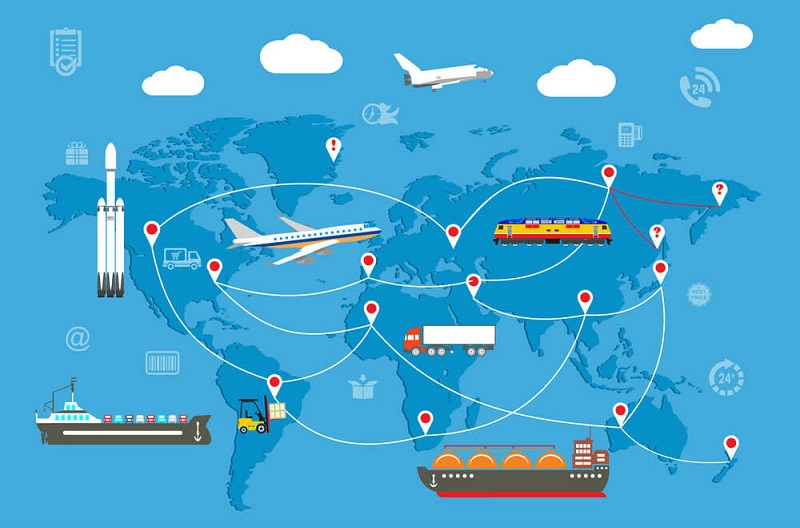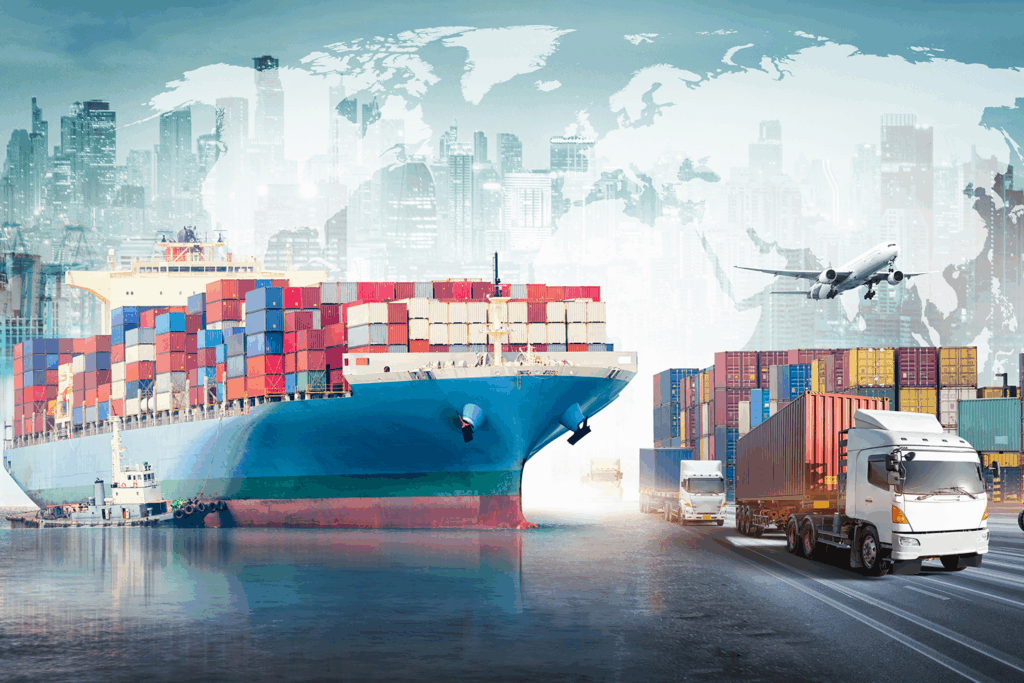Globale Transparenz in der Logistik - Durchbruch im Jahr 2025
Der globale Handel lebt von Geschwindigkeit, Vertrauen und Transparenz. Doch eine der größten Hürden für Unternehmen ist heute die Erreichung globale logistische Sichtbarkeit über Grenzen hinweg. Unternehmen wollen wissen, wo ihre Sendungen sind, wann sie ankommen und wie Ausnahmen gehandhabt werden. Die Kunden erwarten das Gleiche. Doch in der Praxis ist die internationale Transparenz alles andere als einfach.
Dieser Artikel befasst sich mit den wichtigsten Herausforderungen, die einer nahtlosen grenzüberschreitende Sichtbarkeituntersucht, wie sie sich auf die Logistikleistung auswirken, und zeigt praktische Lösungen auf, mit denen Unternehmen die Nase vorn haben.

Warum Sichtbarkeit in der globalen Logistik wichtig ist
Sichtbarkeit bedeutet, ein klares Echtzeitbild der Sendungen zu haben, während sie die Lieferkette durchlaufen. Für internationale Operationen bedeutet dies:
- Verfolgung der Waren vom Werk zum Hafen, durch den Zoll und bis zur endgültigen Lieferung.
- Erkennen von Engpässen, bevor sie den Zeitplan durchkreuzen.
- Weitergabe aktueller Informationen an Kunden und Partner.
Ohne globale logistische Sichtbarkeitriskieren Unternehmen verspätete Lieferungen, steigende Kosten und unzufriedene Kunden. Mit ihr können sie die Unsicherheit verringern, das Vertrauen stärken und die Abläufe optimieren.
Große Herausforderungen bei der Erzielung grenzüberschreitender Sichtbarkeit
1. Fragmentierte Betreiber- und Partnernetze
Jedes Land hat seine eigenen Frachtführer, Spediteure und Logistikunternehmen. Jedes kann unterschiedliche Systeme und Standards verwenden.
- Traditionelles Thema: Datensilos verhindern einen reibungslosen Informationsfluss.
- Auswirkungen: Die Unternehmen müssen mehrere Dashboards oder Tabellenkalkulationen verwalten, was die Effizienz beeinträchtigt.
- Beispiel: An einer Sendung von Asien nach Europa können drei Spediteure und zwei Zollagenten beteiligt sein, so dass es schwierig ist, Aktualisierungen zu konsolidieren.
2. Begrenzte Datenstandardisierung
Logistikdaten gibt es in vielen Formaten: EDI, API, PDF-Dokumente und E-Mails. Ohne Standardisierung wird die Integration von Informationen zu einem großen Hindernis.
- Die Zollbehörden verwenden häufig ältere Technologien.
- Die Betreiber bieten möglicherweise keine Echtzeit-Dateneinspeisung an.
- Nicht übereinstimmende Formate führen zu Verzögerungen bei der Berichterstattung.
Ergebnis: Die Sichtbarkeit ist verzögert oder ungenau, was eine proaktive Entscheidungsfindung unmöglich macht.

3. Zölle und regulatorische Hindernisse
Der grenzüberschreitende Versand ist immer mit einer Zollabfertigung verbunden. Die Zollverfahren sind jedoch von Land zu Land unterschiedlich, und in einigen Ländern wird nach wie vor viel Papier verwendet.
- Verzögerungen: Falsche oder fehlende Dokumente bringen Sendungen an den Grenzen zum Stillstand.
- Komplexität: Die Vorschriften zur Einhaltung der Handelsbestimmungen sind von Region zu Region unterschiedlich.
- Sichtbarkeitslücke: Die Unternehmen verlieren die Fracht oft aus den Augen, sobald sie in die Zollabfertigung gelangt.
4. Technologische Lücken zwischen den Märkten
Entwickelte Regionen können fortschrittliche digitale Logistikinstrumente nutzen, während aufstrebende Märkte noch auf manuelle Systeme angewiesen sind.
- Problem: Sendungen in weniger digitalisierte Regionen "verschwinden" oft aus der Sendungsverfolgung.
- Auswirkungen: Die Unternehmen können ihren Kunden keine genauen Lieferfristen versprechen.
5. Fehlende Echtzeit-Aktualisierungen
Nicht alle Beförderungsunternehmen teilen Aktualisierungen in Echtzeit mit. Einige melden Ereignisse erst, wenn Meilensteine der Zustellung erreicht sind.
- Beispiel: Ein Paket kann tagelang als "in Transit" angezeigt werden, ohne dass der Standort aktualisiert wird.
- Frustration der Kunden: Die Käufer erwarten die gleiche globale logistische Transparenz, die sie bei inländischen E-Commerce-Lieferungen erhalten.
6. Hohe Kosten der globalen Integration
Der Aufbau von Systemen, die alle Spediteure, Partner und Zollbehörden miteinander verbinden, ist teuer.
- Große Unternehmen können in globale OMS- oder TMS-Plattformen investieren.
- Kleine und mittelständische Unternehmen können sich diese Lösungen oft nicht leisten, so dass sie auf manuelle Lösungen angewiesen sind. Verfolgung.

Die Auswirkungen einer schlechten grenzüberschreitenden Sichtbarkeit
- Die Auswirkungen einer schlechten grenzüberschreitenden Sichtbarkeit
- Unzufriedenheit der Kunden
Eine unklare Sendungsverfolgung führt zu mehr "Wo ist meine Bestellung?"-Anfragen. Die Käufer gehen oft von Verspätungen oder verlorenen Paketen aus, was das Vertrauen beschädigt und sie zu Konkurrenten mit besserer Transparenz drängt. - Höhere Kosten
Mangelnde Transparenz führt zu Mehrausgaben für manuelle Eingriffe, Lagergebühren und Strafgelder. Waren, die beim Zoll hängenbleiben, können Standgelder verursachen, während Fehler bei der Streckenführung unnötige Transportkosten verursachen. - Operative Ineffizienz
Die Teams verschwenden Stunden damit, die Daten von Spediteuren und Maklern zusammenzustellen. Anstatt die Zustellrouten zu verbessern, sind die Mitarbeiter mit sich wiederholenden Verwaltungsaufgaben beschäftigt, was die Produktivität senkt und die Widerstandsfähigkeit schwächt. - Risikoexposition
Blinde Flecken erschweren die Aufdeckung von Diebstahl oder Betrug. Es kann vorkommen, dass Sendungen während des Transfers verloren gehen, aber Probleme erst Tage später entdeckt werden. Dies führt zu finanziellen Verlusten und Compliance-Risiken, insbesondere bei hochwertigen Waren.
Herausforderungen meistern: Bewährte Praktiken
In Integrationsplattformen investieren
Moderne Plattformen wie Postpaket bieten ein einziges Dashboard, das Spediteure, Lagerhäuser und Zolldaten miteinander verbindet. Dadurch werden Silos beseitigt und Aktualisierungen konsolidiert.
Gemeinsame Nutzung von Daten in Echtzeit
- Drängen Sie Betreiber und Partner zur Einführung von APIs für Live-Updates.
- Nutzung von IoT-Geräten für die Container- und Lkw-Verfolgung.
Dokumentation standardisieren
- Verwenden Sie nach Möglichkeit digitale Handelsdokumente.
- Automatisieren Sie die Erstellung von Rechnungen, Frachtbriefen und Zollformularen.
Arbeiten Sie mit zuverlässigen Partnern zusammen
- Wählen Sie Logistikanbieter mit bewährten digitalen Fähigkeiten.
- Partnerschaften mit globalen 3PLs, die bereits Integrationen über mehrere Regionen hinweg verwalten.
Prädiktive Analysen verwenden
- Nutzen Sie die KI, um Verspätungen vorherzusehen und alternative Routen zu empfehlen.
- Verwandeln Sie Sichtbarkeitsdaten in verwertbare Erkenntnisse für die Bestands- und Transportplanung.

Die Rolle von Postpaketen bei der grenzüberschreitenden Sichtbarkeit
Postalparcel ist nicht einfach nur ein weiteres Logistik-Tool - es ist ein umfassender globaler Logistik-Transparenzdienst, der für Unternehmen entwickelt wurde, die grenzüberschreitende Abläufe vereinfachen möchten. Anstatt sich mit fragmentierten Systemen, Spediteuren und Zoll-Updates herumzuschlagen, erhalten Unternehmen eine einheitliche Plattform, die Kontrolle, Genauigkeit und Sicherheit bietet.
- Verwaltung der Transportunternehmen
Verbinden und verwalten Sie mehrere Transportunternehmen auf einer Plattform. Postalparcel ermöglicht schnelle Kosten- und Leistungsvergleiche und sorgt für einen nahtlosen Wechsel zwischen den Transporteuren, wenn es zu Unterbrechungen kommt. - Globale Verfolgung
Genießen Sie konsistente Echtzeit-Updates auf internationalen Routen. Selbst bei der Zollabfertigung oder regionalen Übergabe stellt Postalparcel sicher, dass die Sendungen sichtbar bleiben, und beseitigt so blinde Flecken, die normalerweise Unternehmen und Kunden gleichermaßen frustrieren. - Auftrags- und Bestandsverwaltung
Der Lagerbestand ist direkt mit der Auftragsverfolgung verknüpft, so dass Unternehmen immer wissen, was auf Lager ist, was sich auf dem Transportweg befindet und wann Nachschub benötigt wird. Dies reduziert Überverkäufe, verhindert Engpässe und verbessert die Genauigkeit der Auftragsabwicklung. - Transparenz für den Kunden
Statt endloser "Wo ist meine Bestellung"-Anfragen erhalten Kunden proaktive Benachrichtigungen über Lieferfortschritt, Verzögerungen oder Bestätigungen. Das stärkt das Vertrauen und entlastet die Support-Teams.
Mit Postpaketerhalten Unternehmen ein Maß an grenzüberschreitender Transparenz, das früher nur großen Unternehmen vorbehalten war. Jetzt sind diese Tools skalierbar und erschwinglich und ermöglichen es Unternehmen jeder Größe, im globalen Wettbewerb zu bestehen. Und da der internationale Handel immer stärker digitalisiert wird, ist Postalparcel bereits für die Zukunft gerüstet - durch die Integration von prädiktiver Analytik, nachhaltiger Logistikverfolgung und KI-gestützten Erkenntnissen für die nächste Stufe des globalen Lieferkettenmanagements.

Die Zukunft der globalen Logistikvisibilität
Die grenzüberschreitende Logistik entwickelt sich rasch weiter. Zu den künftigen Trends gehören:
- Blockchain-basierte Zollsysteme um das Vertrauen zu stärken und Betrug zu verringern.
- KI-gesteuerte prädiktive Sichtbarkeit die vor Wetter, Streiks oder Staus warnt.
- Einheitliche internationale Datenstandards um die Integration zu vereinfachen.
- Nachhaltige Logistikverfolgungdie einen Überblick über den CO2-Fußabdruck und umweltfreundliche Lieferoptionen geben.
In dem Maße, in dem sich diese Innovationen verbreiten, werden globale Sichtbarkeit wird weniger zu einer Herausforderung als vielmehr zu einer Erwartung werden. Unternehmen, die frühzeitig handeln, werden sich einen Wettbewerbsvorteil verschaffen.
Schlussfolgerung
Erreichen Sie globale logistische Sichtbarkeit über Grenzen hinweg ist eine Herausforderung, aber unerlässlich. Fragmentierte Netze, unterschiedliche Vorschriften und Datenlücken stellen echte Hindernisse dar. Doch mit der richtigen Technologie, Integrationsstrategien und Partnern können Unternehmen diese Hindernisse überwinden.
Postalparcel macht diesen Wandel möglich, indem es Unternehmen hilft, ihre Sendungen nicht nur zu sehen, sondern auch zu verstehen. sie zu kontrollieren, zu optimieren und weltweit zu liefern. Für Unternehmen, die auf internationalen Märkten konkurrieren, ist Sichtbarkeit nicht mehr optional - sie ist die Grundlage für Vertrauen und Erfolg.
Einblicke in die Industrie
Nachrichten über den Posteingang
Nulla turp dis cursus. Integer liberos euismod pretium faucibua








